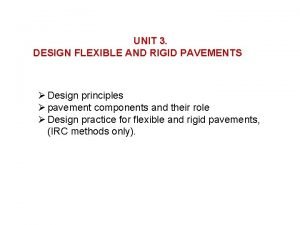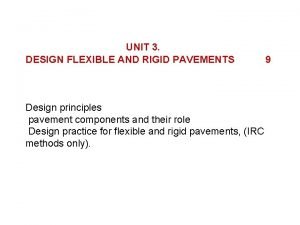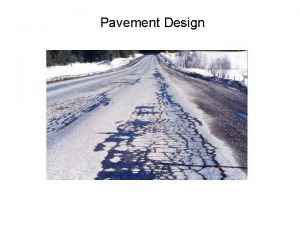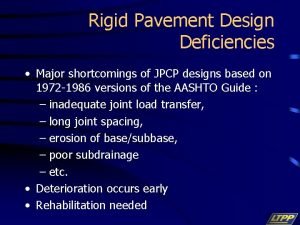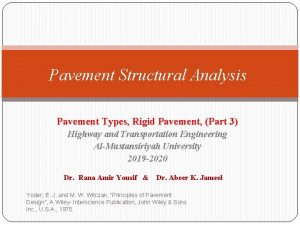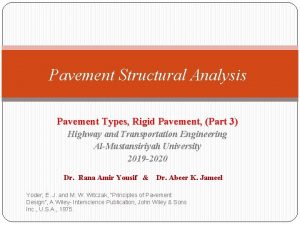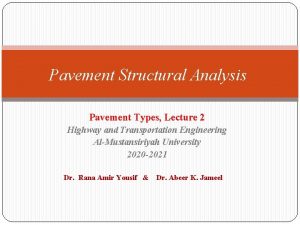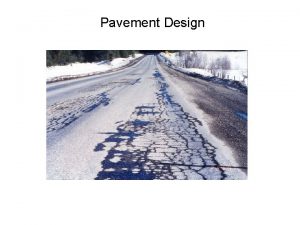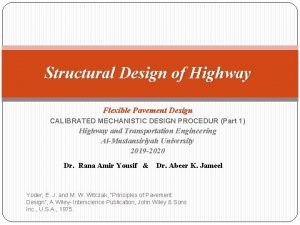Introduction to Pavement Design A highway pavement is























- Slides: 23

Introduction to Pavement Design

A highway pavement is a structure consisting of superimposed layers of processed materials above the natural soil sub-grade, whose primary function is to distribute the applied vehicle loads to the sub-grade.

Requirements of a pavement An ideal pavement should meet the following requirements: *Sufficient thickness to distribute the wheel load stresses to a safe value on the sub-grade soil, * Structurally strong to withstand all types of stresses imposed upon it, * Adequate coefficient of friction to prevent skidding of vehicles, * Smooth surface to provide comfort to road users even at high speed, * Produce least noise from moving vehicles, * Dust proof surface so that traffic safety is not impaired by reducing visibility, * Impervious surface, so that sub-grade soil is well protected, and * Long design life with low maintenance cost.

Types of Pavements The pavements can be classified based on the structural performance into two, (i) flexible pavements and (ii)rigid pavements.

FLEXIBLE PAVEMENT RIGID PAVEMENT

Types of Pavements


Wheel Load Distribution

Flexible Rigid



Flexible pavements will transmit wheel load stresses to the lower layers by grain-to-grain transfer through the points of contact in the granular structure (see Figure 1). The wheel load acting on the pavement will be distributed to a wider area, and the stress decreases with the depth. Taking advantage of this stress distribution characteristic, flexible pavements normally has many layers. Figure- 1

Types of Flexible Pavements Conventional flexible pavements are layered systems with high quality expensive materials are placed in the top where stresses are high, and low quality cheap materials are placed in lower layers. Full - depth asphalt pavements are constructed by placing bituminous layers directly on the soil sub-grade. This is more suitable when there is high traffic and local materials are not available. Contained rock asphalt mats are constructed by placing dense/open graded aggregate layers in between two asphalt layers. Modified dense graded asphalt concrete is placed above the sub-grade will significantly reduce the vertical compressive strain on soil sub-grade and protect from surface water.

Figure-2

Typical layers of a flexible pavement (Refer Figure 2). Seal Coat: Seal coat is a thin surface treatment used to waterproof the surface and to provide skid resistance. Tack Coat: Tack coat is a very light application of asphalt, usually asphalt emulsion diluted with water. It provides proper bonding between two layers of binder course and must be thin, uniformly cover the entire surface, and set very fast. Prime Coat: Prime coat is an application of low viscous cutback bitumen to an absorbent surface like granular bases on which binder layer is placed. It provides bonding between two layers. Unlike tack coat, prime coat penetrates into the layer below, plugs the voids, and forms a water tight surface.

Surface course: Surface course is the layer directly in contact with traffic loads and generally contains superior quality materials. They are usually constructed with dense graded asphalt concrete (AC). The functions and requirements of this layer are: * It provides characteristics such as friction, smoothness, drainage, etc. Also it will prevent the entrance of excessive quantities of surface water into the underlying base, sub-base and sub-grade, * It must be tough to resist the distortion under trafic and provide a smooth and skid- resistant riding surface, * It must be water proof to protect the entire base and subgrade from the weakening effect of water.

Binder course: This layer provides the bulk of the asphalt concrete structure. It's chief purpose is to distribute load to the base course The binder course generally consists of aggregates having less asphalt and doesn't require quality as high as the surface course, so replacing a part of the surface course by the binder course results in more economical design. Base course: The base course is the layer of material immediately beneath the surface of binder course and it provides additional load distribution and contributes to the sub-surface drainage. It may be composed of crushed stone, crushed slag, and other untreated or stabilized materials.

Sub-Base course: The sub-base course is the layer of material beneath the base course and the primary functions are to provide structural support, improve drainage, and reduce the intrusion of fines from the sub-grade in the pavement structure. A sub-base course is not always needed or used. Sub-grade: The top soil or sub-grade is a layer of natural soil prepared to receive the stresses from the layers above. It is essential that at no time soil sub-grade is overstressed. It should be compacted to the desirable density, near the optimum moisture content.

Failure of flexible pavements: The major flexible pavements are: • Fatigue Cracking, • Rutting, and • Thermal Cracking.

Rigid pavements have sufficient flexural strength to transmit the wheel load stresses to a wider area below. A typical cross section of the rigid pavement is shown in Figure 3. Figure-3 Typical Cross Section of Rigid Pavement

In rigid pavement, load is distributed by the slab action, and the pavement behaves like an elastic plate resting on a viscous medium (Figure 4). Figure 4: Elastic plate resting on Viscous foundation

Types of Rigid Pavements: Jointed Plain Concrete Pavements: These are plain cement concrete pavements constructed with closely spaced contraction joints. Dowel bars or aggregate interlocks are normally used for load transfer across joints. They normally have a joint spacing of 5 to 10 m. Jointed Reinforced Concrete Pavement: Although reinforcements do not improve the structural capacity significantly, they can drastically increase the joint spacing to 10 to 30 m. Dowel bars are required for load transfer. Reinforcement helps to keep the slab together even after cracks. Continuous Reinforced Concrete Pavement: Complete elimination of joints are achieved by reinforcement. Pre-stressed Concrete Pavements:

Failure criteria of rigid pavements *Traditionally fatigue cracking has been considered as the major, or only criterion for rigid pavement design. *Of late, pumping is identified as an important failure criterion.
 Flexible pavement
Flexible pavement Design chart for flexible pavement
Design chart for flexible pavement Flexible and rigid pavement
Flexible and rigid pavement Objectives of geometric design in roads
Objectives of geometric design in roads Flexible pavement design equation
Flexible pavement design equation Pavement structural design
Pavement structural design Cbr method of pavement design
Cbr method of pavement design Asphalt institute
Asphalt institute Thickness of flexible pavement formula
Thickness of flexible pavement formula Standard axle load for pavement design
Standard axle load for pavement design Cdfu meaning
Cdfu meaning Cross section of flexible pavement
Cross section of flexible pavement Austroads pavement design guide
Austroads pavement design guide Objectives of pavement design
Objectives of pavement design Flexible pavement design / aashto method example
Flexible pavement design / aashto method example Dfaringe
Dfaringe Aashto rigid pavement design spreadsheet
Aashto rigid pavement design spreadsheet Faa pavement design software
Faa pavement design software Hcm 1985
Hcm 1985 Traffic and highway engineering 4th edition
Traffic and highway engineering 4th edition Mole highway
Mole highway Life is a highway analysis
Life is a highway analysis All traffic signs and meanings
All traffic signs and meanings Rac electric highway charging station
Rac electric highway charging station
